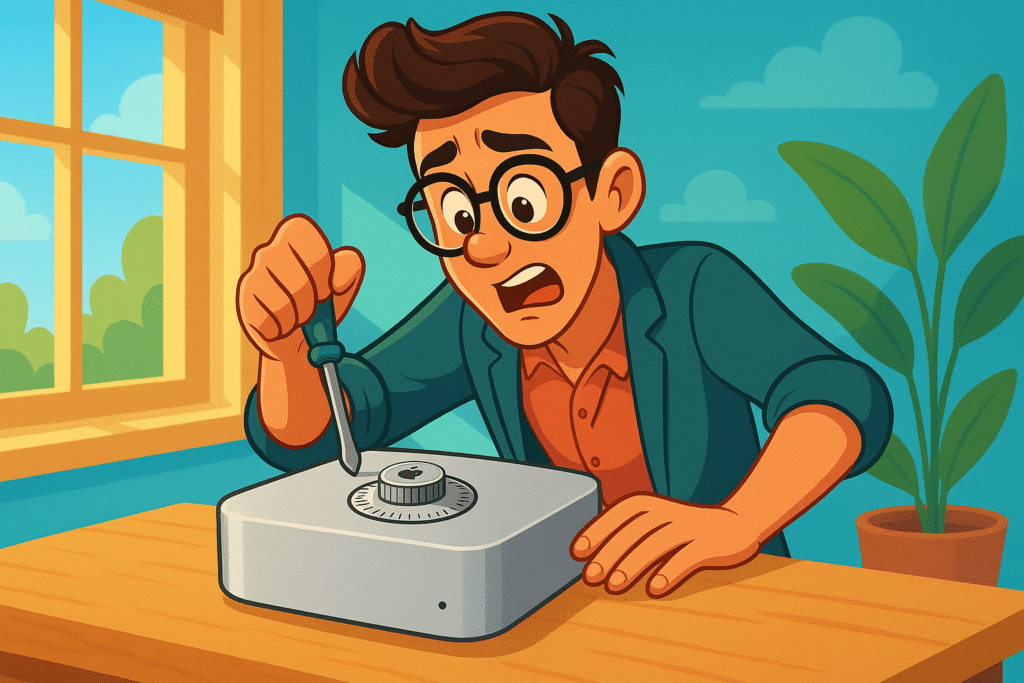
My partner loves her iMac, but finally got tired of waiting for Apple to release a new 27″ model. Fair enough — it’s been years, and the waiting game gets old as her computer chugs to run increasingly demanding apps.
So I hatched what I thought was a brilliant plan:
Buy a souped-up Mac Mini paired with an Apple Studio Display. Perfect combo, right? Similar performance, same beautiful screen quality, and a more flexible setup.
(The monitor is expensive, but NOBODY makes a 6K one like Apple, plain and simple. And with a Studio Display, at least it doesn’t follow the CPU into obsolescence like an iMac’s screen does.)
Here’s where my clever hack came in: I’d order the Mini M4 Pro with the smallest solid-state drive option (saving thousands of dollars) and have my favorite tech wizard replace it with a huge third-party SSD for a fraction of Apple’s upgrade price.
When you look at Apple’s pricing, you understood why this matters so much. Upgrading the M4 Mac mini from its base 256GB SSD to 2TB costs an eye-watering US $800 through Apple.
And if you want 4TB? That’s not even an option unless you jump to the pricier M4 Pro model like I did — effectively a $1,400 premium over the base $599 Mac mini.
I’d done this kind of upgrade dance before with previous Macs. It was a reliable way to get maximum performance without paying Apple’s premium storage tax.
With Apple’s first M-series chips, the SSD was soldered directly to the motherboard. No slots, no sockets, no hope for DIY upgrades.
It infuriated buyers like me, with Apple seemingly doing an end run on our solution.
But I’d heard rumors that Apple’s newest Mac mini had returned to a modular SSD design, technically making upgrades possible again.
A glimmer of hope!
And then when I visited my tech guy, my reality was more complicated: “Yes, it’s modular now, but there are proprietary controls and I can’t source a compatible drive for it. Like, anywhere.”
So despite Apple’s shift back to a modular design, the practical reality for most people like me remains unchanged. The components may no longer be physically soldered to the motherboard, but they might as well be if compatible replacement parts are unfindable.
This illustrates a broader trend in modern product design — what I call “theoretical repairability.”
Manufacturers can claim their products are technically repairable while still maintaining complete control through proprietary parts, specialized tools, or software locks.
In I Need That, I talk about how ownership has evolved from a relationship where we control and modify what we buy, to one where we merely license the right to use something as the manufacturer dictates.
Apple’s storage pricing strategy is a perfect example.
By making aftermarket upgrades effectively impossible despite a modular design, they ensure that consumers pay their premium upfront or live with limited storage.
Product Payoff: American computer maker Framework built an entire laptop business by going beyond theoretical repairability to actual user serviceability. Their modular laptops (and now desktops) not only allow component swaps but use standard parts and provide clear documentation. This approach has earned them a passionate following among tech enthusiasts. While they’re still a tiny niche player compared to Apple, their year-over-year growth proves there’s a substantial market of customers who value these freedoms. As e-waste concerns grow and sustainability becomes more important to consumers, brands that enable longer product lifespans through TRUE upgradability are positioned to capitalize on changing preferences.
Action for today: Evaluate your product’s “repairability theater.” Are there places where you claim flexibility but actually limit customer options? Being honest about these limitations can build trust, while finding areas to genuinely open up may create competitive advantages in a world increasingly concerned with sustainability and consumer rights.
Encountered any products that appeared to be user-serviceable but weren’t in practice?
Or found brands that go beyond lip service to enable true repairability? Tap that reply arrow and share your experiences navigating the sometimes frustrating world of product upgrades.
Or reach out to my amazing team of product product strategy specialists at Graphos Product.
